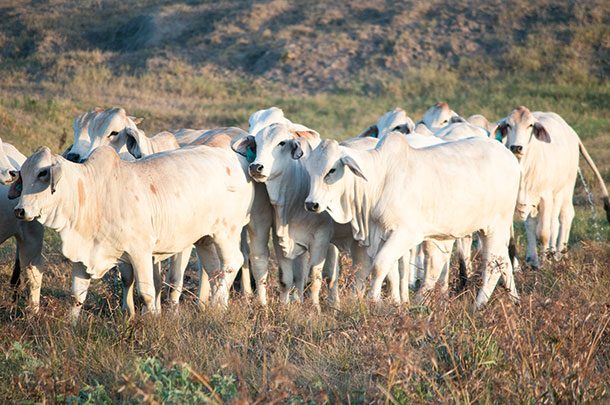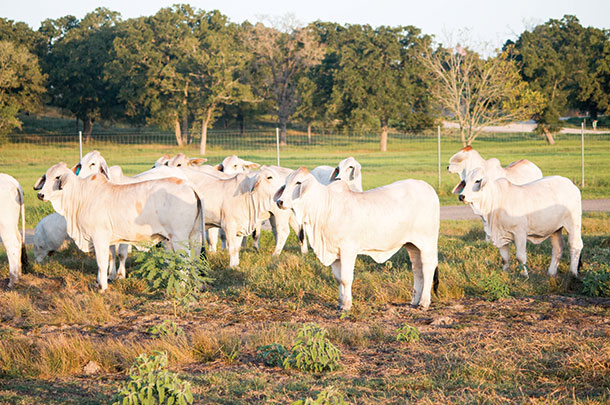The Vassberg family’s work at Kallion Farms goes back to 1996, when his father, Byron Vassberg, turned his attention from farming to building a Brahman seedstock ranch upon graduating from Texas A&M in 1987. The farm operated under the Kallion Farms name along with the cattle operation that runs livestock on 5,000 acres.
Eventually Grant assumed control of the cattle side of Kallion Farms, while Byron focused primarily on the crop-farming operations. And with that transition to younger management came a heavier emphasis on younger cattle.

Fresh cattle are the primary tools on the seedstock side, which features 350 registered females and a host of recipient females in the commercial side. Much like the breeding cows, recip cows are coming in on the younger side.
“I’ll roll the dice on young females or the new bulls,” Grant Vassberg explains. “I’m trying the youngest of the best. But that’s really how we’ve achieved so much success. If I waited for a cow to be 7 years before I flush her, I’d be way behind.”
Vassberg says the Brahman reputation may be unfairly maligned for its carcass qualities – something he and his father have worked for years to improve. But overall, the goal with younger females and bulls is to create a balanced genotype that works for the heart of Texas cattle country.
“Sometimes we get a reputation for only being focused on carcass quality, but our operation is focused on creating the complete animal – temperament, fertility, maternal and carcass traits – everything.”
Roger Hunsley, a retired professor at Purdue University and former CEO for the American Shorthorn Association, worked with the Vassbergs for several years starting in 2003.
“I’ve spent some time with the Vassbergs, and there’s not another Brahman program in the world that knows more about their cattle than that one,” says Hunsley. “That herd at Kallion Farms is a very elite group of genetics.”
Fertility
Vassberg applies the standard that younger cattle produce results. Heifers routinely begin cycling between 15 and 18 months, with young bulls able to produce semen at the same ages. “Early puberty is usually a great reference point with a high correlation to fertility over its whole life,” Vassberg says.
“Females that hit puberty at an early age are the ones cranking out calves.”
Targeting those age ranges has helped build longevity in the herd. Vassberg doesn’t hesitate to thin out cows with problems or defects.
“There’s no slack at all for bad bags and skipping calves or dummy calves. Otherwise, you would end up spending most of your time putting up with these problems.”
One trait he doesn’t cull is the Brahman cow’s protective instincts for the calf. “Some want it, some don’t. But the big ranchers who need animals to take care of calves, they love that trait. So I won’t cull for her being protective of the calf.”
Kallion Farms’ herds have never had birthweight problems, he explains. The average bull is around 73 pounds, and heifers are around 67.
Temperament
The same tight approach is followed with any ill-tempered cattle that come through the genetic line.
“I’ve seen it where the temperament of the animal is influenced by genetics. Therefore, we don’t give any slack to temperament.
“We’ve culled animals that were off the charts in traits like marbling. But if the temperament is off, it’s gone from the operation. We’re focused on creating the complete animal.”

The ranch saw improvements to herd temperament after it started recording data that would be used in temperament scores. Applying a scorecard developed in part by Hunsley, the Vassbergs gave scores – from 0 to 5, with 0 being most docile – to calves starting at weaning, before growing familiar with human interaction.
“Temperament scoring is still based on what you see with your eyes, so we just wanted to do some things you can substantiate and document to moderate the temperament of those breeds,” says Hunsley, who has worked with 25 breeds of cattle on docility standards.
“Some other breeds have had that temperament problem, but in the Brahman there’s been a preponderance issue going back through some common ancestry. A lot of people in that breed work with calves early, when still on their mothers.
But you can’t make temperament. It’s genetic. It’s going to be passed on. So we evaluated it three to four times a year, at weaning, yearling and when your sections are made to put them in the herd.”
Vassberg says that in the beginning, 90 percent of the cattle were “wild,” but today, “It’s flipped to almost 80 percent being docile. At weaning, we sort each animal into solo confinement, and in 2015, 80 percent calmly stood there and didn’t care. That’s the progress we’ve made in 15 years.”
Carcass data
Vassberg says innovations in carcass quality were embraced early at Kallion Farms, first with genetics but then toward ultrasound.
“That’s where we took the operation to the next level. We tested over 3,000 head for the DNA markers in marbling and tenderness, and that’s where the foundation herd started."
"Since then, we have narrowed it down for cattle that could also perform well in other areas such as fertility, docility and performance, such as weaning and yearling weights.”
Then with ultrasound, he started scanning bulls and heifers at 12 months old for intramuscular fat and ribeye area, and all steers would get sheer force scoring data under Warner-Bratzler scores.
Intramuscular fat scores started around 3.0, with Brahman averaging as a breed around 3.5. Today, Kallion Farms’ average scores easily hit 4.5 at a year old and a range from 4.0 to 6.9. The Warner-Bratzler sheer force tests are now well below 8 pounds.
“If you go to a meat scientist, they’ll tell you anything over 11 pounds is unacceptable,” says Hunsley. “The breed was always criticized for not having enough marbling at the dinner plate. So we worked very hard on tenderness and sheer scores. Some of the steaks we had out of the Brahman were as good as any from Hereford, Shorthorn or Angus.”
Ongoing genetics
Vassberg cites the ranch’s work with embryo transfer as a defining technology and one that has embraced the use of younger cattle.
“My top female, even though she’s a young heifer, I’ll make 15 to 20 calves from her. And we’ve done that for several generations deep.
“Most of your registered Brahman breeders, when you say a donor cow, you think of an 8-year-old cow with genetics. My average donor is 18 months old. I’ve used a 13-month-old heifer. I always take the best of the younger group and continue moving forward.”
“What you see (with Kallion Farms) is what happens in 13 to 15 years of pretty intense selection, not just for temperament but for a number of traits,” says Hunsley. ![]()
PHOTO 1: Grant Vassberg, managing owner of Kallion Farms, with a few friendly cows at the College Station, Texas, ranch.
PHOTO 2: Brahmans at Kalliion Farms
PHOTO 3: Kallion Farms targets a number of goals for dams, including fertility, maternal and carcass traits, that go beyond temperament. Photos by David Cooper.

-
David Cooper
- Managing Editor
- Progressive Cattleman
- Email David Cooper







